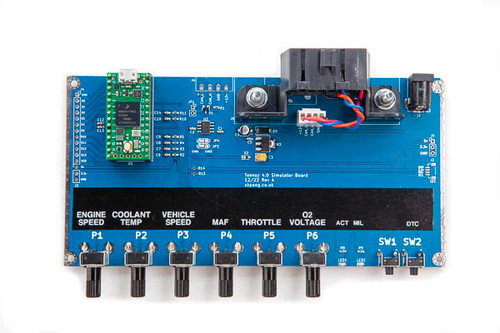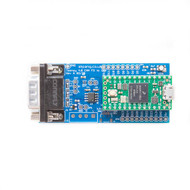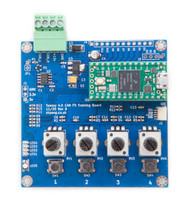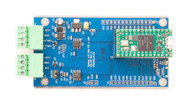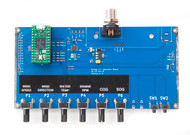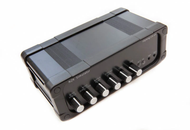Product Description
Free Shipping Within the United States!
This compact and powerful OBD-II ECU simulator is built around the Teensy 4.0 microcontroller (included and pre-installed), offering a versatile platform for developing and testing OBD-II diagnostic tools, vehicle telemetry software, and custom CAN-Bus applications. Whether you're building your own scan tool, developing automotive software, or teaching OBD-II fundamentals, this board provides a realistic and adjustable simulation of an automotive Electronic Control Unit (ECU).
With six built-in potentiometers for on-the-fly adjustment of key engine parameters, developers and educators can simulate varying engine conditions and behaviors in real time.
Power Requirements
-
Operates on 12 VDC.
-
A universal 12 VDC power adapter is included for immediate setup and use.
Hardware Features
-
Teensy 4.0 module (installed)
-
Pre-programmed with custom OBD-II ECU simulator firmware
-
Fully compliant with ISO 15765-4 (CAN 11-bit, 500 kbps) – the dominant protocol for modern OBD-II communication
-
OBD-II female diagnostic connector with 12V line
-
6 potentiometers for live simulation of engine sensor data via PIDs
-
Open-source firmware – extend and customize to your project needs
Firmware Features
The firmware adheres to the SAE J1979 OBD-II standard, supporting the following diagnostic modes:
-
Mode 01 (Current Data): Real-time sensor data and status of monitored systems
-
Mode 02 (Freeze Frame): Stored data snapshot from when a fault was detected
-
Mode 03 (Stored DTCs): Diagnostic Trouble Code retrieval for powertrain issues
Simulated PIDs Include:
-
Engine RPM (PID 0C) – adjustable to simulate idle to redline
-
Throttle Position Sensor (PID 11) – fine-tune response with potentiometer
-
Vehicle Speed Sensor (PID 0D) – simulate speed from 0 to highway levels
-
Coolant Temperature (PID 05) – simulate cold start to overheated engine
-
Mass Air Flow (MAF) Sensor (PID 10) – essential for fuel delivery modeling
-
Oxygen Sensor Voltages (PIDs 14–1B) – simulate upstream/downstream readings
Additional Capabilities
-
Diagnostic Trouble Code (DTC) Simulation: Set and clear DTCs to test code-reading tools and service logic
-
Extensible PID List: Add support for additional PIDs or custom sensor data with ease
Ideal Use Cases
-
Automotive tool and software developers
-
Embedded systems engineers working with CAN
-
Automotive diagnostics training programs
-
Hobbyists and makers working on car hacking or vehicle simulators
Customizable and Expandable
The simulator's open-source firmware allows for easy expansion. Developers can modify the firmware to support other OBD-II modes (e.g., Mode 04 – Clear DTCs, Mode 09 – VIN and calibration ID) or to add proprietary PIDs for advanced diagnostics and research.
This simulator brings a real-world OBD-II testing environment to your desktop—without needing a vehicle.
Download the PDF: Teensy Software Installation & Downloading Programs (Sketches)...
Documents
- Teensy 4.0 OBD-II CAN Bus ECU Simulator - Schematic (PDF)...
- Teensy 4.0 OBD-II CAN Bus ECU Simulator - Demo Sketch...
More Resources
The Five OBD-II Protocols
The CAN Bus today serves as the basis for OBD2 communication in the vast majority of cars through ISO 15765.
Note: The Teensy 4.0 OBDII CAN-Bus ECU Simulator supports only ISO 15765 (CAN Bus).
However, older cars (pre-2008) may use one the other four protocols that have been used as basis for OBD2.
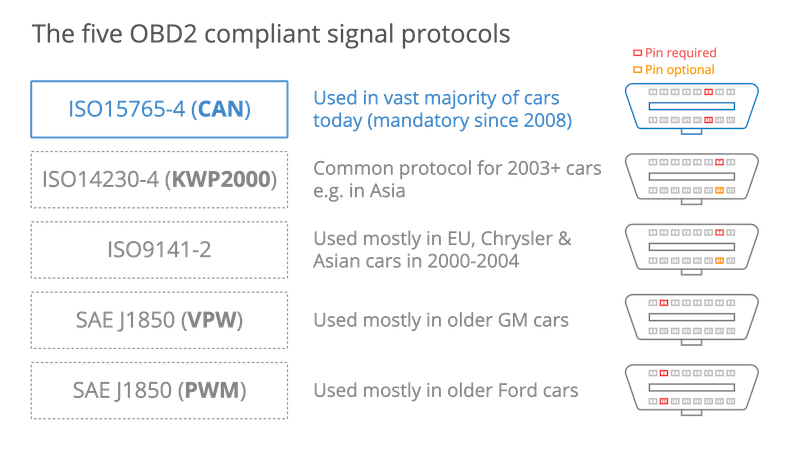
- ISO 15765 (CAN bus): Mandatory in US cars since 2008 and is today used in the vast majority of cars
- ISO14230-4 (KWP2000): The Keyword Protocol 2000 was a common protocol for 2003+ cars in e.g. Asia
- ISO9141-2: Used in EU, Chrysler & Asian cars in 2000-04
- SAE J1850 (VPW): Used mostly in older GM cars
- SAE J1850 (PWM): Used mostly in older Ford cars
 OBD-I & OBD-II: A Complete Guide to Diagnosis, Repair, & Emissions Compliance
OBD-I & OBD-II: A Complete Guide to Diagnosis, Repair, & Emissions Compliance
Onboard diagnostics (OBD) systems have been an integral part of vehicle design for decades, as OBD-II became mandatory in 1996 for all cars manufactured in the United States. Almost every aspect of the diagnostics system evolved from emissions requirements in the automotive industry. Manufacturers reacted with growing complexity in the electronic controls and reporting of errors. Fortunately, some commoditization followed in the industry, which made the job of a repair technician or do-it-yourself enthusiast slightly easier when working on these demanding systems.
Passing emissions testing has become critically important to high-performance parts and installation shop manufacturers. The US Environmental Protection Agency (EPA) and California Air Resources Board (CARB) have assessed enormous fines for violations of the Clean Air Act based on information available from the vehicle's OBD system. Many states now require vehicles to pass an OBD check to renew the registration, making proper operation even more important to consumers. OBD-I & OBD-II: A Complete Guide to Diagnosis, Repair, & Emissions Compliance is an insider's guide to modern original equipment manufacturer (OEM) diagnostics systems. More Information...
 Loading... Please wait...
Loading... Please wait...

